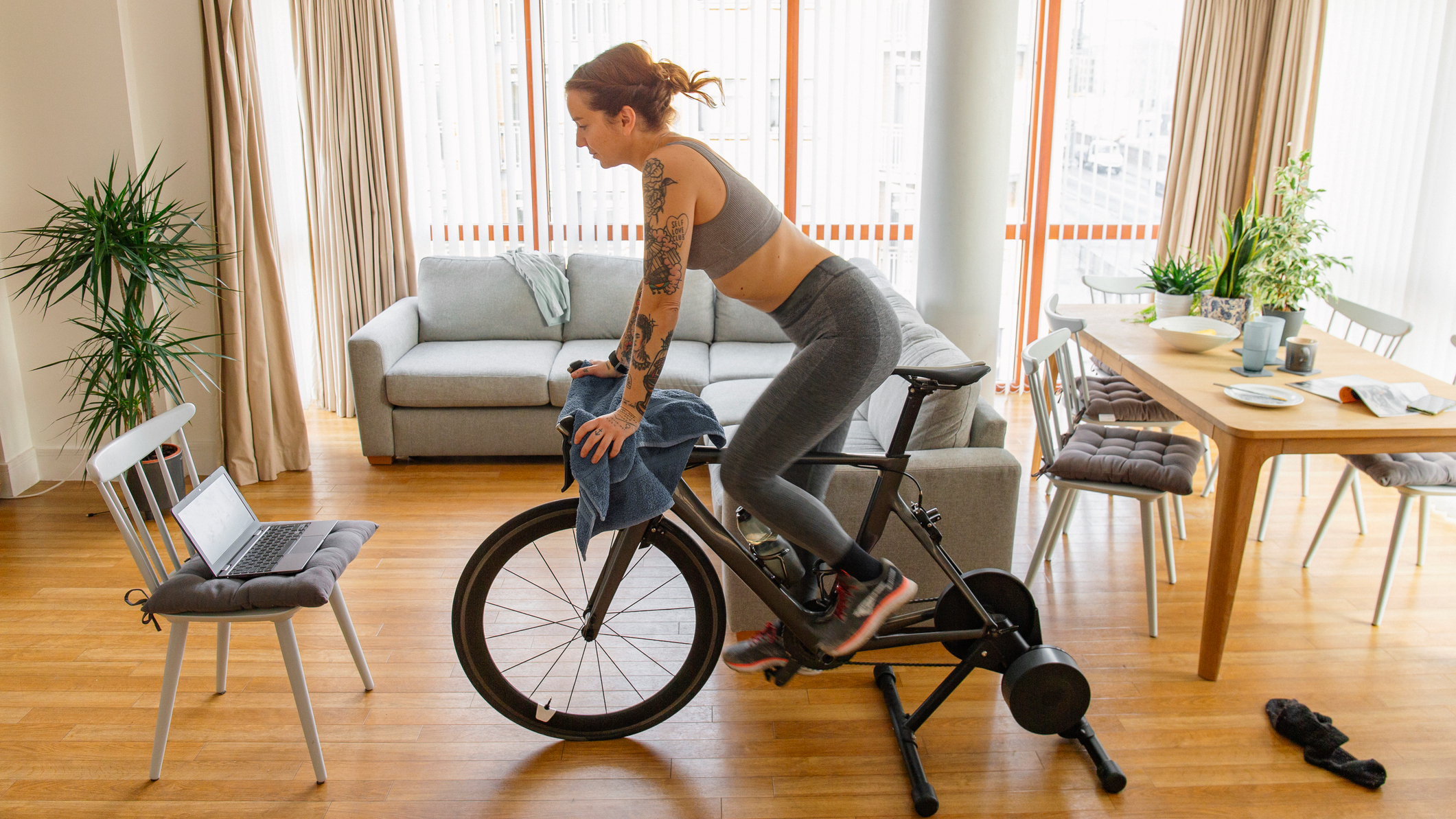How indoor cycling can make you a better runner — use this expert advice to get fitter and faster
Use indoor cycling to improve your running

There are lots of ways you can improve as a runner and one of the most common is to increase the amount of training you do. It’s not always easy to do this purely through running more, however, because running is a high-impact sport and you can risk injury by doing more of it.
Many runners, including myself, increase the amount of training they do by cycling, and doing indoor cycling in particular. Using one of the best exercise bikes is a convenient and low-impact way to do more cardiovascular training, and the fitness benefits apply to running directly.
That’s especially true if you set up your bike in a certain way, and adjust your riding position and style to better mimic running. To get more advice on how to best use indoor cycling to improve your running I spoke to Dr Barney Wainwright, applied sport scientist and senior research fellow at Leeds Beckett University.
Wainwright has worked with endurance athletes for 30 years and has created some specific cycling for runners workouts for Wattbike, one of which you can find below.
Dr Barney Wainwright is an applied and research sports scientist and a senior research fellow at Leeds Beckett University. Wainwright has worked with endurance athletes at all levels across many sports, including running, cycling and cross-country skiing. He was a member of Team GB as a sports scientist at the Athens and Beijing Olympic Games, and Team Canada at the Vancouver Winter Olympics.
How does indoor cycling benefit runners?
“There's a lot of shared benefits between both sports,” says Wainwright. “Like central cardiovascular benefits, also some of the more localized benefits around capillarization, increase of mitochondria. And we can manipulate the cycling side of the movement to have a better crossover to running.”
Cycling is also a lower-impact sport than running, which makes it a good way to increase your training volume with a lower risk of injury, perhaps as a step towards increasing the amount of running you do.
You can sometimes also use the bike to replace running when rehabbing an injury you can’t run with, and it’s easy to control how hard you work on the bike. Just like any indoor form of training, cycling inside also means you can train more easily when it’s dark outside or the weather is horrendous.
Get instant access to breaking news, the hottest reviews, great deals and helpful tips.
How do runners make indoor cycling more like running?
“If we look at the two normal positions of cycling and running, they're quite different,” says Wainwright. Running is very upright, and when biking, we're more bent over.
“Out of saddle cycling is a much closer replacement, so do as much riding out of the saddle as possible. Then it's using very similar muscles for loading and driving backwards through the pedal stroke like you are when you're running.
“We've got a similar body orientation. A lot of the joints, particularly around the hip, are moving through a very similar range of motion, so we're able to use the glutes as well. Whereas in cycling the glutes can often be switched off like.
"And we also get a bit more loading because you are actually loading each leg at a time as we are when we're running.” You can adjust the setup of your indoor bike to make it more suitable for supporting this style of riding, and more like running in general.
“Set the handlebars a bit higher, to be more upright, move the saddle a bit further forwards, and raise it up a little bit as well,” says Wainwright. “Often when we're cycling, particularly runners not used to being on a bike, we end up with quite a low saddle. That means you end up cycling with a very bent knee all the way around, which is very different to running, where we extend our knees completely.”
“We'd normally look for a knee angle of about 150 degrees at its maximum at the bottom of the pedal stroke. We're never looking for 180 — there’s still a bend — but it's not a 90-degree bend.”
Is there a difference between indoor and outdoor cycling for runners?
You can get all the benefits from cycling for running through outdoor rides as well training indoors, but there are some advantages to indoor cycling. One is being able to adjust the saddle and handlebars extensively, because indoor exercise bikes usually allow for a wider range of positions. It’s also usually easier, and safer, to get a workout done indoors than outdoors.
“For example, if you wanted to do some high intensity work on a bike, you need hills, really, and they need to be quite long hills, and there needs to be little traffic and traffic lights and all those kinds of things,” says Wainwright. “If you're on the flat, you've got to go quite fast, particularly if you're a fit person or fit runner, and then the speed can get a little bit dangerous unless you're a really good cyclist.
“But saying that if you're in a great place and you just want to use cycling to help your running and get two or three hours of biking in, then absolutely no problem at all. There's no reason why you can't do it outdoors, it’s just far more difficult to control the intensity. Even with elite road cyclists, we're still doing quite a lot of indoor work just because we can control the intensity.”
What kind of cycling workouts should runners do?
You can use indoor rides to replicate any kind of running workout, or to add to your running. I mostly do 30-45 minute low intensity easy rides to increase my training volume, and on Wainwright’s advice will now change my approach to these to include more riding out of the saddle.
“Set a repeat timer for one minute on, one minute off,” says Wainwright. “One minute in the saddle, one minute out of it. What you will find is when you're out of the saddle, you often need to increase the resistance slightly, because you're supporting your bodyweight as well.”
Wainwright has also contributed several cycling workouts for runners to the Wattbike Hub app, which include instructions on how to set up your bike and ride out of the saddle. One such workout you can try is below.
30-minute indoor cycling workout for runners
This 30-minute workout is perfect for adding on at the end of a run to extend your training session, or doing at another point to make it a double-workout day. The whole workout takes 30 minutes including a warm up and cool down.
“Start with an eight minute progressive warm up,” says Wainwright. “I'm talking FTP [functional threshold power] language because that's what we've got on the app.”
To find out your FTP you can take quite a vicious test where you ride as hard as you can for a set period. Many indoor exercise bikes, sports watches and apps will also give you an estimate after a few rides.
Having a rough idea of your FTP is important for getting the most out of cycling workouts as the effort levels suggested will usually be tailored to your score. If you have one of their bikes, you can also use Peloton to do an FTP test.
“Start at 60% FTP, which is pretty steady, and every every couple of minutes you increase the intensity to end up at 100% FTP. Ideally, you do some of that work in the saddle and some out of the saddle to get used to that.
“The main interval work block is six lots of 60 seconds out of the saddle at 100% FTP and then two minutes back in the saddle at 75% FTP. It’s a light interval session, keeping a controlled low cadence [pedal revolutions per minute], between 70 and 80.
“Then you have a six minute progressive cool down. We tend to refer to the cool down as not necessarily a cool down, but just a low intensity period to get the body a bit more relaxed before we get off the bike.”
More from Tom's Guide
- Treadmill vs exercise bike — which is a better workout?
- We've tested the best exercise bikes to help you boost your fitness at home
- Wattbike Atom Next Generation review

Nick Harris-Fry is an experienced health and fitness journalist, writing professionally since 2012. He spent nine years working on the Coach magazine and website before moving to the fitness team at Tom’s Guide in 2024. Nick is a keen runner and also the founder of YouTube channel The Run Testers, which specialises in reviewing running shoes, watches, headphones and other gear.
Nick ran his first marathon in 2016 and became obsessed with the sport. He now has PBs of 2hr 25min for the marathon and 15min 30sec for 5K. Nick is also a qualified Run Leader in the UK.
Nick is an established expert in the fitness area and along with writing for many publications, including Live Science, Expert Reviews, Wareable, Coach and Get Sweat Go, he has been quoted on The Guardian and The Independent.
